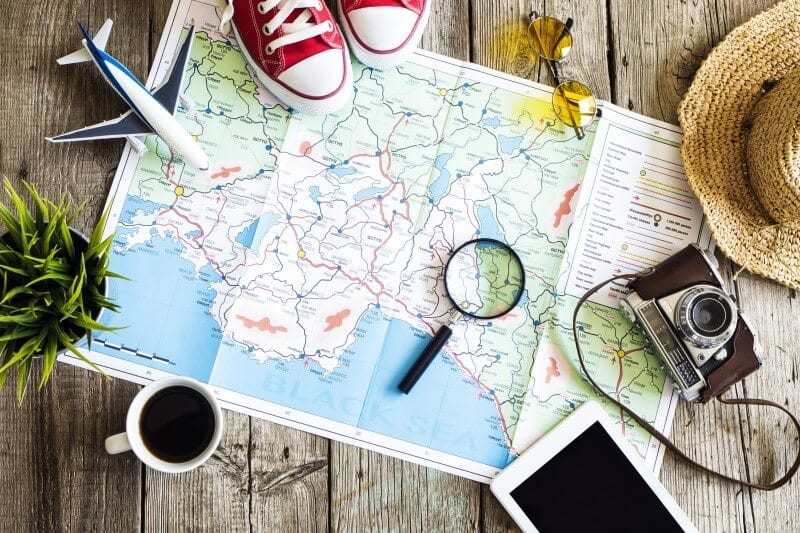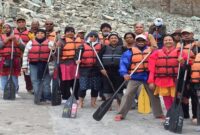Adventure trips for seniors offer a thrilling opportunity to explore the world, challenge oneself, and create lasting memories. This guide delves into the exciting possibilities, covering everything from choosing the right adventure to planning logistics and budgeting effectively. Whether you’re seeking a low-impact walking tour or a more challenging hike, we’ll help you find the perfect adventure to suit your fitness level and interests. We’ll explore diverse destinations, offering insights into accessibility, safety, and the unique appeal of various adventure types.
From meticulously curated packing lists to insightful tips on finding affordable travel deals, we aim to provide a comprehensive resource for seniors eager to embark on unforgettable adventures. We will examine the importance of pre-trip health assessments and travel insurance, ensuring your safety and peace of mind. With detailed examples of various trips, including hiking expeditions, relaxing river cruises, and wildlife safaris, this guide will empower you to plan and execute your dream adventure.
Defining “Adventure Trips” for Seniors
Adventure trips for seniors redefine the typical image of retirement travel. They offer engaging experiences that cater to varying levels of physical ability and personal interests, fostering a sense of accomplishment and rejuvenation. The key is to carefully match the adventure level to the individual’s capabilities, ensuring a safe and enjoyable experience.
Adventure travel for seniors encompasses a wide spectrum of activities, ranging from gentle strolls through scenic landscapes to more challenging hikes and explorations. The appropriate level of adventure depends significantly on the individual’s physical fitness, health conditions, and personal preferences. It’s crucial to consider pre-existing medical conditions and any limitations in mobility, stamina, or balance when selecting an adventure trip.
Adventure Trip Categories Based on Fitness Levels
Categorizing adventure trips by impact level helps seniors choose suitable options. Low-impact trips minimize strain on joints and muscles, while moderate and high-impact trips progressively increase the physical demands.
Low-impact activities prioritize gentle movement and exploration, focusing on enjoyment rather than strenuous exertion. Moderate-impact activities introduce a greater degree of physical challenge, while still remaining accessible to most seniors with average fitness. High-impact activities demand a higher level of physical fitness and endurance, and are suitable only for seniors with excellent physical condition and prior experience in similar activities.
Examples of Low-Impact Adventure Trips
Low-impact adventures are designed for relaxation and gentle exploration, focusing on minimizing physical exertion. They are ideal for seniors who prefer a slower pace and prioritize comfort and enjoyment over intense physical activity.
- Scenic train journeys through picturesque landscapes, offering comfortable viewing and minimal physical activity.
- Guided walking tours of historical sites or charming towns, with frequent rest stops and opportunities to enjoy local culture.
- Relaxing cruises on calm waters, allowing for leisurely sightseeing and onboard activities with minimal physical demands.
- Visits to botanical gardens or national parks with accessible pathways and well-maintained facilities, enabling exploration at a comfortable pace.
Examples of Moderate-Impact Adventure Trips
Moderate-impact trips offer a balance between physical activity and relaxation, catering to seniors with a moderate level of fitness and endurance. These trips often involve activities that require a moderate level of physical exertion, but are still manageable for most seniors with good health.
- Kayaking or canoeing on calm lakes or rivers, providing gentle exercise and opportunities for wildlife viewing.
- Hiking on relatively flat trails with minimal elevation gain, allowing for exploration of natural environments at a moderate pace.
- Cycling tours on paved paths or dedicated bike lanes, offering a comfortable and enjoyable way to explore new areas.
- Multi-day walking tours with manageable distances and gradual elevation changes, combining physical activity with cultural exploration.
Examples of High-Impact Adventure Trips
High-impact adventure trips are designed for seniors with excellent physical fitness and prior experience in demanding activities. These trips often involve strenuous physical activity and require a high level of endurance and stamina.
- Backpacking or trekking in mountainous regions, requiring excellent physical condition and experience in navigating challenging terrain.
- Rock climbing or mountaineering expeditions, demanding significant physical strength, endurance, and specialized training.
- White-water rafting or kayaking on challenging rivers, requiring strong swimming skills and experience in handling fast-moving currents.
Accessibility and Safety Considerations for Senior Adventure Trips
Prioritizing accessibility and safety is paramount when planning adventure trips for seniors. This involves careful consideration of individual needs and potential risks, ensuring a safe and enjoyable experience for all participants. Proper planning can mitigate potential hazards and maximize the enjoyment of the trip.
- Choosing accessible accommodations and transportation options that cater to the needs of seniors with mobility limitations.
- Selecting activities and destinations that are appropriate for the fitness levels and health conditions of the participants.
- Ensuring adequate medical support and emergency services are available throughout the trip.
- Providing clear and concise instructions and safety guidelines to all participants.
- Utilizing experienced and qualified guides who are familiar with the needs of senior travelers.
Popular Destinations for Senior Adventure Trips
Choosing the right destination is crucial for a successful senior adventure trip. Factors such as accessibility, climate, and the availability of suitable activities all play a significant role in ensuring a safe and enjoyable experience. This section highlights three diverse locations catering specifically to the needs and preferences of active seniors.
Three Diverse Destinations for Senior Adventurers
The following table outlines three popular destinations, each offering unique experiences and levels of accessibility. These locations represent a balance between adventure and relaxation, ensuring a fulfilling trip for senior travelers.
| Location | Activity Highlights | Accessibility Features | Price Range |
|---|---|---|---|
| Costa Rica | Wildlife viewing (sloths, monkeys, toucans), gentle rainforest hikes, zip-lining (adapted options available), birdwatching tours, relaxing on pristine beaches. | Many eco-lodges offer accessible rooms and facilities. Guided tours can be adapted to suit various fitness levels. Wheelchair-accessible transportation is available in tourist areas. | Mid-range to Luxury (depending on accommodation and tour choices) |
| Scottish Highlands, Scotland | Scenic drives through breathtaking landscapes, leisurely walks along lochs and glens, boat trips on calm waters, visits to historic castles and distilleries. | Many trails offer gentle gradients and well-maintained paths. Accessible transportation is readily available in towns and villages. Boat tours often have wheelchair-accessible areas. | Mid-range to Luxury (depending on accommodation and tour choices) |
| Sedona, Arizona, USA | Mild hikes with stunning red rock views, jeep tours, exploring vortex sites (energy points), visiting art galleries and Native American cultural sites, enjoying spa treatments. | Many trails offer shorter, less strenuous options. Jeep tours can accommodate wheelchairs. Accessible transportation and accommodations are available in the town of Sedona. | Mid-range to Luxury (depending on accommodation and tour choices) |
Climate and Seasonal Considerations
Climate plays a significant role in planning a senior adventure trip. Understanding seasonal variations is essential for ensuring comfort and safety.
Costa Rica enjoys a tropical climate, with temperatures remaining relatively consistent year-round. However, the rainy season (May-November) can impact outdoor activities. The dry season (December-April) offers the best weather for hiking and wildlife viewing. The Scottish Highlands experience a temperate maritime climate, characterized by mild winters and cool summers. The best time to visit is during the summer months (June-August) when the weather is generally dry and sunny. However, be prepared for unpredictable weather at any time of year. Sedona, Arizona, has a desert climate with hot, dry summers and mild winters. The best time to visit is during the spring (March-May) or fall (September-November) when temperatures are moderate. Summer can be extremely hot, while winter nights can be chilly.
Types of Adventure Trips for Seniors
Adventure travel for seniors doesn’t mean scaling Mount Everest. It’s about finding exciting and fulfilling experiences tailored to different fitness levels and interests. This section explores various trip types, highlighting their unique features and suitability for older travelers. We’ll consider factors like physical exertion, accessibility, and the overall experience to help you choose the perfect adventure.
Walking Tours and Hiking Adventures
Walking tours offer a gentle introduction to new cultures and landscapes. They combine moderate physical activity with opportunities for sightseeing and learning. Examples include guided walking tours of historical cities like Rome or Seville, focusing on manageable distances and comfortable paces. Alternatively, consider multi-day hiking trips in national parks like the Great Smoky Mountains National Park, featuring shorter trails with breathtaking scenery and accessible accommodations. These trips emphasize exploration at a pace suitable for seniors.
- Example 1: A week-long walking tour of the Cotswolds in England, focusing on charming villages and picturesque landscapes. This tour includes comfortable accommodations and manageable daily walks.
- Example 2: A five-day hiking trip in Acadia National Park, Maine, featuring shorter, well-maintained trails with stunning coastal views and accessible lodging options.
Cruises
Cruises provide a comfortable and convenient way to explore multiple destinations. Many cruise lines cater specifically to older travelers, offering accessible amenities, engaging onboard activities, and shore excursions tailored to various fitness levels. Examples include luxury river cruises along the Rhine or Danube, or voyages to the Caribbean with easy access to beaches and attractions. These trips offer a blend of relaxation and exploration, minimizing physical strain.
- Example 1: A luxury river cruise on the Rhine, featuring comfortable staterooms, onboard lectures, and guided excursions to charming riverside towns.
- Example 2: A Caribbean cruise with accessible amenities, including elevators and ramps, and shore excursions tailored to seniors’ interests, such as historical tours or leisurely beach visits.
Wildlife Safaris
Wildlife safaris offer the chance to witness incredible animals in their natural habitats. While some safaris involve strenuous activities, many are designed for all fitness levels. Options include guided game drives in open-top vehicles in national parks like Kruger National Park in South Africa, offering comfortable seating and knowledgeable guides. Alternatively, consider walking safaris in locations with gentler terrain, providing a more intimate experience with nature.
- Example 1: A guided game drive in the Serengeti National Park, Tanzania, offering comfortable viewing from an open-top vehicle and opportunities to spot the “Big Five”.
- Example 2: A walking safari in Botswana’s Okavango Delta, focusing on gentler terrain and providing a closer look at wildlife and birdlife.
Train Journeys
Train journeys offer a relaxed and scenic way to travel, providing comfortable seating and opportunities to enjoy the passing landscape. Examples include scenic routes like the Rocky Mountaineer in Canada or the Trans-Siberian Railway in Russia. These journeys often incorporate planned stops at interesting destinations, allowing seniors to explore at their own pace. The convenience and comfort of train travel are particularly appealing to older travelers.
- Example 1: A journey on the Rocky Mountaineer, showcasing stunning mountain scenery and comfortable accommodations.
- Example 2: A segment of the Trans-Siberian Railway, offering a unique cultural experience and breathtaking landscapes.
Cultural Immersion Tours
Cultural immersion tours focus on experiencing local traditions, customs, and history. These tours often involve moderate walking and visits to historical sites and cultural attractions, but at a relaxed pace. Examples include exploring ancient ruins in Peru, learning about local crafts in Vietnam, or attending cultural performances in Japan. These trips emphasize learning and engagement, prioritizing comfort and accessibility.
- Example 1: A guided tour of Machu Picchu, Peru, with comfortable transportation and opportunities to learn about Inca history and culture.
- Example 2: A cultural immersion tour of Japan, featuring visits to temples, gardens, and traditional tea ceremonies.
Comparison of Adventure Trip Types for Seniors
The choice of adventure trip depends heavily on individual preferences and physical capabilities.
- Walking Tours/Hiking:
- Pros: Moderate exercise, cultural immersion, scenic views.
- Cons: Can be strenuous for some seniors, requires a certain level of fitness.
- Cruises:
- Pros: Convenient, comfortable, multiple destinations.
- Cons: Can be crowded, limited opportunities for independent exploration.
- Wildlife Safaris:
- Pros: Unique wildlife viewing opportunities.
- Cons: Can be physically demanding (depending on the type of safari), potential for long travel days.
- Train Journeys:
- Pros: Relaxed travel, scenic views, comfortable accommodations.
- Cons: Limited flexibility, potential for long travel times.
- Cultural Immersion Tours:
- Pros: Engaging cultural experiences, learning opportunities.
- Cons: Can involve moderate walking, requires some level of physical stamina.
Planning and Logistics of Senior Adventure Trips
Planning a senior adventure trip requires meticulous attention to detail to ensure a safe, enjoyable, and memorable experience. Factors such as health, travel insurance, and logistical arrangements significantly impact the overall success of the trip. Thorough preparation minimizes potential problems and maximizes the opportunity for adventure.
Pre-Trip Health Assessments and Necessary Precautions
Pre-trip health assessments are crucial for senior adventurers. A comprehensive check-up with their physician is recommended, focusing on any pre-existing conditions, medication requirements, and potential risks associated with the planned activities. This assessment should include discussions about necessary vaccinations, altitude sickness precautions (if applicable), and strategies for managing chronic illnesses during travel. The physician can provide specific advice on physical fitness levels required for the trip and suggest modifications or alternative activities if needed. For example, a senior with heart conditions might need to avoid strenuous hikes and opt for gentler walks or scenic drives. Similarly, those with mobility issues might require accommodations like accessible transportation and lodging. Carrying a detailed medical history, including a list of medications and allergies, is essential for emergencies.
Travel Insurance Options and Their Relevance to Senior Adventurers
Travel insurance is paramount for senior adventurers, offering crucial protection against unforeseen circumstances. Standard travel insurance policies often have limitations for seniors, particularly regarding pre-existing conditions. Therefore, it’s vital to choose a comprehensive policy that specifically covers medical emergencies, evacuations, trip cancellations, and lost luggage. Some policies even offer specialized coverage for adventure activities. For instance, a policy covering activities like hiking or kayaking would be beneficial for a senior planning a multi-day trek. Comparing policies from different providers is recommended to find the best coverage at a reasonable price. The cost of insurance will often increase with age and the level of activity planned. Consider the potential costs of medical care abroad, which can be significantly higher than in one’s home country. A robust insurance plan can provide financial security and peace of mind.
Step-by-Step Guide to Booking and Planning a Senior Adventure Trip
Planning a senior adventure trip involves a methodical approach. The following steps provide a framework:
- Define the Trip’s Scope: Determine the desired destination, type of adventure, trip duration, and budget. Consider the physical capabilities and interests of the senior traveler(s).
- Research Destinations and Activities: Research potential destinations that align with the defined scope, focusing on accessibility and suitability for seniors. Explore available activities and tours catering to senior fitness levels.
- Secure Travel Insurance: Obtain comprehensive travel insurance that covers medical emergencies, evacuations, and other potential issues specific to senior travelers and the chosen activities.
- Book Flights and Accommodation: Book flights and accommodation, considering accessibility needs (e.g., wheelchair access, elevators). Look for hotels or resorts with senior-friendly amenities.
- Arrange Transportation: Plan transportation between the airport, accommodation, and activity locations. Consider using private transportation services or accessible public transport.
- Confirm Activities and Tours: Book any planned activities or tours, ensuring they are suitable for the senior traveler’s fitness level and interests. Confirm cancellation policies.
- Pack Appropriately: Pack comfortable and appropriate clothing, footwear, and any necessary medications. Prepare a detailed itinerary and share it with family or friends.
- Prepare for Emergencies: Create a contact list of emergency numbers and share the itinerary with someone at home. Pack a small first-aid kit.
Essential Gear and Packing for Senior Adventurers
Packing appropriately for a senior adventure trip is crucial for comfort, safety, and enjoyment. Overpacking can lead to fatigue and discomfort, while underpacking can leave you unprepared for unexpected situations. This section details essential gear and provides a structured packing list to help you prepare for your adventure. Remember to always check the specific requirements and recommendations for your chosen trip.
Packing List for Senior Adventure Trips
Careful planning of your packing list is paramount. This list is a template; adapt it to the specific activities and climate of your chosen adventure. Consider factors like the length of the trip, the type of terrain, and the weather conditions.
| Item | Notes |
|---|---|
| Comfortable, Supportive Hiking Boots | Broken-in boots are essential to prevent blisters and foot pain. Choose boots with good ankle support and waterproof capabilities if necessary. Consider a lighter option for less strenuous activities. |
| Moisture-Wicking Socks (Multiple Pairs) | Wool or synthetic materials are best for wicking away moisture and preventing blisters. Pack at least three pairs to allow for drying. |
| Lightweight, Breathable Clothing (Layers) | Layering allows you to adjust to changing temperatures. Pack moisture-wicking base layers, insulating mid-layers (fleece or down jacket), and a waterproof outer shell. |
| Sun Hat and Sunglasses | Essential for protection from the sun, especially at higher altitudes. Choose a wide-brimmed hat for maximum coverage. |
| Sunscreen (High SPF) and Lip Balm with SPF | Protect your skin from harmful UV rays, even on cloudy days. Reapply frequently, especially after sweating or swimming. |
| First-Aid Kit | Include bandages, antiseptic wipes, pain relievers, any personal medications, and any other items specific to your health needs. |
| Backpack (Appropriate Size) | Choose a backpack that fits comfortably and is the right size for your trip. Avoid overly large packs that can cause strain. |
| Water Bottle or Hydration Reservoir | Staying hydrated is crucial, especially during physical activity. Consider a hydration reservoir for hands-free hydration. |
| Headlamp or Flashlight | Useful for navigating in low-light conditions. Ensure you have extra batteries. |
| Insect Repellent | Protect yourself from mosquito bites and other insects, particularly in tropical or wooded areas. |
| Camera and Extra Batteries | Capture memories of your adventure. Bring extra batteries to avoid missing photo opportunities. |
| Personal Medications | Bring a sufficient supply of any prescription or over-the-counter medications you need. |
| Walking Stick or Trekking Poles (Optional) | Can provide additional stability and support, especially on uneven terrain. |
| Quick-Drying Towel | A lightweight, quick-drying towel is essential for hygiene and comfort. |
| Toiletries | Pack travel-sized toiletries to save space and weight. |
The Importance of Comfortable and Supportive Footwear and Clothing
Appropriate footwear and clothing are paramount for a comfortable and safe adventure. Poorly fitting shoes can lead to blisters, foot pain, and even injuries. Clothing should be lightweight, breathable, and allow for layering to adapt to changing weather conditions. Choosing moisture-wicking materials will help prevent discomfort and chafing. For example, a well-broken-in pair of hiking boots with good ankle support will significantly reduce the risk of sprains and blisters, while moisture-wicking socks will keep your feet dry and comfortable. Similarly, layered clothing allows for temperature regulation, preventing overheating or getting too cold. This adaptability is crucial for maintaining comfort and energy levels throughout the trip.
Wrap-Up
Embarking on an adventure trip as a senior is a rewarding experience that fosters personal growth, exploration, and connection with the world. By carefully considering your fitness level, choosing appropriate destinations and activities, and planning meticulously, you can create an unforgettable journey. This guide provides a roadmap to navigate the process, ensuring your adventure is both safe and enjoyable. Remember, the most important element is choosing an experience that aligns with your interests and capabilities, allowing you to embrace the thrill of adventure while prioritizing your well-being.




